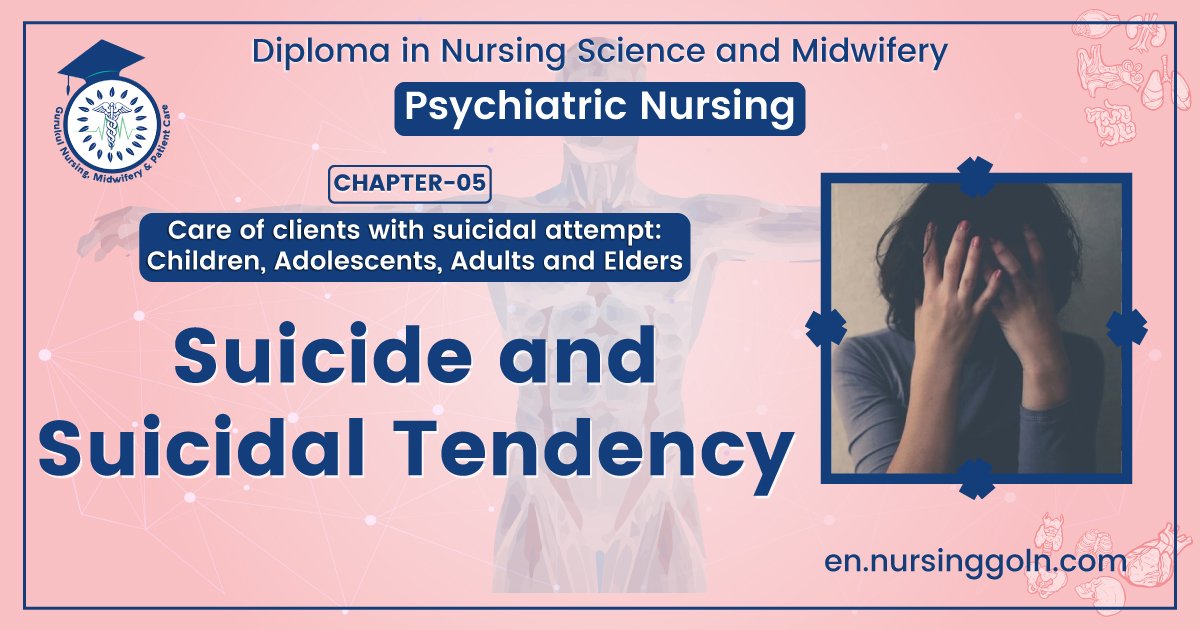Suicide and suicidal tendency – This book covers the entire syllabus of “Psychiatric Nursing” prescribed by the Universities of Bangladesh- for Basic and diploma nursing students. We tried to accommodate the latest information and topics. This book is an examination-friendly setup according to the teachers’ lectures and examination questions.
At the end of the book previous university questions are given. We hope in touch with the book students’ knowledge will be upgraded and flourish. The unique way of presentation may make your reading of the book a pleasurable experience.

Suicide and suicidal tendency
Suicide:
“The conscious act of self-induced annihilation as a multidimensional malaise in a need ful individual, who defines an issue for which the act is perceived as the best solution”.
[Ref: KP Neeraja/1/Vol-1/321]
Or,
Suicide has been defined as an act with a fatal outcome that is deliberately initiated and performed by the person in the knowledge or expectation of its fatal outcome
[Ref- Michael Gelder/5/408]
Or,
Suicide/ is intentional self-inflicted death. Suicidal ideation, gesture and attempted suicide are the most common psychiatric emergencies. A suicide attempt is an act of self-damage. If the patient dies as a result of the act it is called suicide
(Ref-S. Nambilst/222)
Causes of suicide:
1. Isolated feeling- feeling of alienation
2. Loneliness
3. Intolerable psychological pain
4. Severe frustration
5. Hopelessness and helplessness-desperate cry for help
6. Ambivalent feelings or conflicts between survival and unbearable stress
7. Suffering with severe pain
8. Exciting scene
9. Communication of intention
10. Life long patterns of failure, stress, threats to self-esteem
11. Aggressive act towards self
12. Violent behaviour, act of revenge
13. Stressors of conflict
14. Separation and rejection
15. Unfulfilled needs, desires
16. Guilty, shame, humiliation
17. Narrowed perception seeking escape
[Ref: KP Neeraja/1/Vol-1/321]
Risk factors for suicide:
1. Psychiatric illness (depressive illness, schizophrenia).
2. Older age.
3. Male sex.
4. Living alone.
5. Unemployed.
6. Recently bereaved divorced or separated.
7. Chronic physical ill health.
8. Drug or alcohol misuse.
9. Suicide note written.
10. History of previous attempts (especially if a violent method was used).
[Ref-Davidson’s/24 edition]
Or,
1. Family history of suicide
2. Family history of child maltreatment
3. Previous suicide attempt(s)
4. History of mental disorders, particularly clinical depression
5. History of alcohol and substance abuse
6. Feelings of hopelessness
7. Impulsive or aggressive tendencies
8. Cultural and religious beliefs (e.g., belief that suicide is noble resolution of a personal dilemma)
9. Local epidemics of suicide
10. Isolation, a feeling of being cut off from other people
11. Barriers to accessing mental health treatment
12. Loss (relational, social, work, or financial)
13. Physical illness
14. Easy access to lethal methods
15. Unwillingness to seek help because of the stigma attached to mental health and substance abuse disorders or to suicidal thoughts

Signs of impending suicide:
1. Addiction.
2. Sleeping too much or too little
3. Isolation.
4. Social withdrawal
5. Lack of interest in personal appearance.
6. Lack of interest in friends.
7. Lack of interest in social activities.
8. Poor performance in school
9. Boredom, restlessness, lack of concentration.
10. Withdrawing from friends and family
11. Depressive mood.
12. Declining interest in sex, friends or activities previously enjoyed.
13. Neglect of personal welfare,
14. Deteriorating physical appearance.
15. Alterations pattern in sleeping pattern or eating habits.
16. Self-starvation, dietary management, disobeying medical instructions (specially in elderly).
17. Changes in appetite, weight, behaviour, level of activity, lack of energy.
[Ref: KP Neeraja/I/Vol-1/324]
Management of a patient of suicidal tendency
1. Give the patient an opportunity to express his feelings.
2. Improve communication by a sympathetic approach.
3. Strengthen self-esteem by supportive psychotherapy and reassurance.
4. Facilitate problem-solving by:
✓ identifying the problems,
✓ identifying the alternatives,
✓ being clear of the situation and practical solution,
✓ choosing one alternative and following it up
5. Make a treatment plan
6. Try to persuade the client to accept it.
7. Decide whether the client should be admitted to hospital or treated as an OPD or IPD. It all depends on –
✔ The intensity of the suicidal intention
✔ The severity of any associated psychiatric illness.
✔ The availability of social support system
8. If it is OPD case, ask their telephone number with address, tell them they can call at any time if need arises.
9. If the case is significant, inpatient care is required.
[Ref: S Nambi/2/208+ KP Neeraja/1″/Vol-1/326]

Care of a suicidal patient in hospital:
Arrangement requires –
1. Adequate staffing
2. Vigilance
3. Special nursing arrangements to avoid keeping alone, e.g., client room has to be located near the nurses station to maximize observation by the nursing staff
4. Formulate and state clearly the policies protocol and it has to be agreed by client and the staff, e.g., only family members will be allowed
5. In case of adolescents limit the friend circle.
6. Conduct suicide assessment, lethality plan
7. Engage the client in purposeful activities by diverting the mind
8. Careful observation of the client is needed in vulnerable time
9. Provide symptomatic psychotherapeutic treatment.
10. Treat the underlying cause, before the exact treatment started
11. Administer the drugs, if any prescribed
12. Report to the team members if any clues related to suicide are identified 13. Encourage the client to develop optimistic ideas or sense of hope and self-controland 31
14. Motivate the client to express his repressed feelings
15. Involve the family members in provision of care and guide them to provide situational zai support
16. Refer high risk cases for psychotherapeutic interventions.
[Ref: KP Neeraja/F/Vol-1/326]
Care of potential suicidal patient in community:
1. Assessment of client, relatives, review the suicidal risk tendency
2. Organization of adequate social support, regular review
3. Involve family members in provision of care with adequate situational support
4. Arrange immediate access to extra help for client and relatives
[Ref: KP Neeraja/P/Vol-1/326]
Prevention of suicidal tendency:
Primary Prevention:
1. Improve the skills of team members in identifying high risk clients and in planning the treatment or care, e.g. carrying counselling sessions.
2. Never allow the high-risk cases to be alone, engage them in purposeful productive activities
3. Refer high risk cases for psychotherapeutic intervention
4. Early recognition and prompt treatment of the psychiatric disorders and problems associated with it
5. Identify the stressors, assist the family and the client to modify the stressful situation
6. Educate the community, focus groups, e.g., teachers, parents, adolescents about the high-risk tendency, means and methods of handling the situation by overcoming coping strategies, crisis intervention strategies
7. Guidance and counselling services for high-risk groups to adjust to the society.

Secondary Prevention:
1. Establishment of
➤ Crisis prevention and counselling centres
➤ Hotlines
2. Improve the availability and quality of help for those who may be contemplating suicide
3. Guidance and counselling services for the suicide attempters who are at risk
4. Arrange for screening high risk groups and arrange supportive services
5. Organize awareness campaigns for the resource persons, e.g. teachers, community leader, community volunteers to identify the symptoms of suicidal tendency and refer them for institutional cafe
6. Encourage the public for free interaction pattern
7. Provide treatment for the actual suicidal crisis in clinics, telephone hotlines and in hospitals.
Tertiary Prevention:
1. Interventions with family and friends of a person, who has committed suicide, e.g. guidance, counselling, psychotherapy, family therapy, diversional therapy etc.
2. Minimizing the residual effects of suicidal attempts
3. Follow up and planned
4. Supportive system has to be strengthened.
[Ref: KP Neeraja/1″/Vol-1/327]
Read more:
